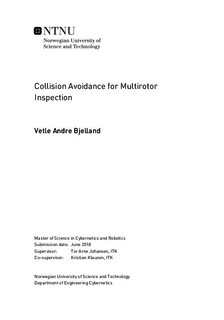Collision Avoidance for Multirotor Inspection
Master thesis
Permanent lenke
http://hdl.handle.net/11250/2616150Utgivelsesdato
2018Metadata
Vis full innførselSamlinger
Sammendrag
During the last couple of years, the goal of using unmanned aerial vehicles (UAV)for inspection purposes has become within reach. This thesis considers the differentalgorithms for implementing a high level controller for an anti-collision systemfor a multirotor inspection drone operating inside a shipping tank. The desired platformfor this thesis is a quadcopter UAV with six on-board radar sensor, providingenvironmental knowledge. A literature review of existing collision avoidance algorithmsis performed to consider which ones that are suited for tank inspection. Thelinearized dynamic quadcopter mathematical model is derived and simulated with lowlevel PID-control and high level collision avoidance in a self-developed MATLAB simulator.The methodology of the algorithms implemented is explained and divided intotwo groups; those considering the environment to be known (global), and the onescontinuously sensing the environment from the on-board radar sensors (local). TheNull-Space Based (NSB) behavioral control algorithm is tested as a global approach.A self-developed reactive logic algorithm and the Velocity Obstacle (VO) algorithmare tested as local approaches for collision avoidance. The results yielded from thedifferent algorithms simulations show successful inspection with room for improvementon the implemented collision avoidance. The remarks of the simulation resultsare discussed and it is suggested to extend the self-developed reactive logic algorithmfor future work.
